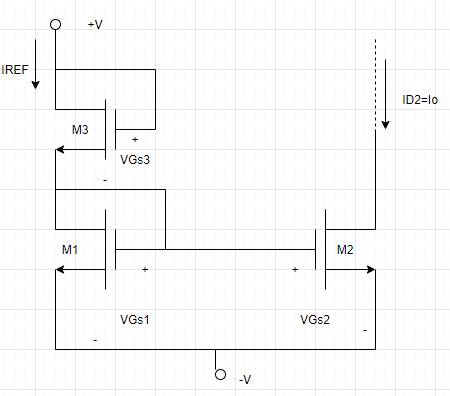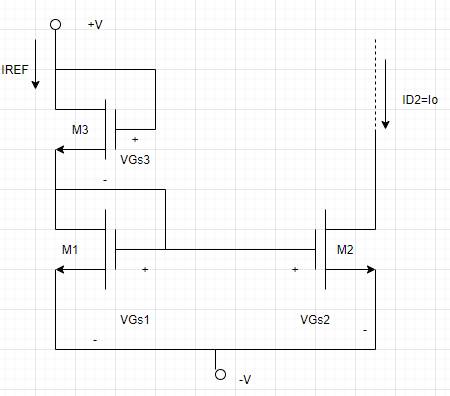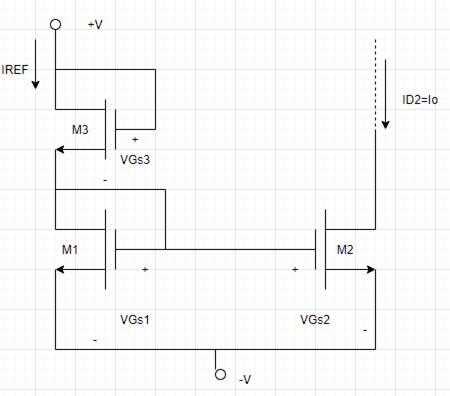
(a)
The reference current
(a)
Answer to Problem 10.51P
Explanation of Solution
Given:
The circuit parameters are
The transistor parameters are
Calculation:
Consider the circuit shown below.

Transistor
Also,
From equation substitute the value of
Also,
The reference current is,
Conclusion:
(b)
The load current
(b)
Answer to Problem 10.51P
Explanation of Solution
Given:
The circuit parameters are
The transistor parameters are
Calculation:
Consider the given circuit as shown below.

The transistor
From equation (1) put the value of
Also,
Now the load current is,
The load resistance will be,
Now the load current for
Now the change in load current,
Conclusion:
(c)
The load current
(c)
Answer to Problem 10.51P
Explanation of Solution
Given:
The circuit parameters are
The transistor parameters are
Calculation:
Consider the given circuit as shown below.

The transistor
From equation (1) put the value of
Also,
Now the load current is,
The load resistance will be,
Now the load current for
Now the change in load current,
Conclusion:
Want to see more full solutions like this?
Chapter 10 Solutions
Microelectronics: Circuit Analysis and Design
- Don't use ai to answer I will report you answerarrow_forwardDon't use ai to answer I will report you answerarrow_forwardChose the correct answer: 1- A squirrel cage induction motor is not selected when (A) initial cost is the main consideration (B) maintenance cost is to be kept low (C) higher starting torque is the main consideration (D) all above considerations are involved 2- The torque of an induction motor is .............. (A) directly proportional to slip (B) inversely proportional to slip... (C) proportional to the square of the slip (D) none of the above 3- Insertion of resistance in the stator of an induction motor. (A) increases the load torque (B) decreases the starting torque (C) increases the starting torque (D) none of above tool to slip 10 or of the above 4- Increase in the length of air-gap in the induction motor results in the increasing of its (A) air-gap flux (B) magnetizing current (C) speed (D) power factor 5- In cumulatively cascade method for speed controlling, if PA is the number of poles of main motor and PB is the number of poles of auxiliary motor. Then the speed of the set…arrow_forward
- Chose the correct answer: 1- The resultant flux in stator winding of three-phase induction motor is equal to (A) Maximum value of flux due to any phase (B) Twice of the maximum value of flux due to any phase. (C) 0.5 times the maximum value of flux due to any phase (D) 1.5 times the maximum value of flux due to any phase 2- Which one of the following starters cannot be used for 3-phase, star - connected, slip-ring induction motor? (A) Auto-transformer starter (B) Star-delta starter (C) Direct-on-line starter (D) Rotor resistance starter 3- The crawling in the induction motor is caused by.............. (A) low voltage supply (B) high loads (D) improper design of the machine (C) harmonics developed in the motor 4- The 'cogging' of an induction motor can be avoided by........... (A) good ventilation (B) using DOL starter (C) star-connecting of stator winding (D) having number of rotor slots more or less than the number of stator slots 5- The method which can be used for the speed control…arrow_forwardManual solution only, no Al usedarrow_forwardChoose the correct answer: 1- The stator core of a 3- phase induction motor is laminated in order to reduce the Eddy current loss ) Weight of the stator (B) Hysteresis loss (C) Both eddy current and hysteresis loss - In cumulatively cascade method for speed controlling of a 3-phase induction motor, if PA is the number of poles of main motor and P, is the number of poles of auxiliary motor. Then the speed of the motor B is given by Ⓐ120f/ PA + PB CO (B) 120f/PA-Ps (C) 120f/PA (D) 120f/ Ps 3-Direct online starter is used for 3- phase induction motors having capacity COOOO ⑭Ⓐ Less than 5 h.p. (B) Less than 10 h.p. (C) Greater than 10 h.p. (D) For any capacity motor 4-Crawling of a 3- phase induction motor is a phenomena mainly associated with (B) 5th harmonics Ⓒ) 7 th harmonics (D) 2nd harmonics (A) 3rd harmonics 5-Cogging in a 3- phase induction motor is caused --------- (Ⓐ) If the number of stator slots are equal to number of rotor slots (B) If the motor is running at fraction of its…arrow_forward
- Choose the correct answer: 1-We avoid line starting of induction motor and use starter because... (A) It will run in reverse direction (B) It will pick up very high speed and may go out of step Motor takes five to seven times its full load current (D) Starting torque is very high 2-DOL starting of induction motors is usually restricted to........... A Low horsepower motors (D) High speed motors (B) Variable speed motors (C) High horsepower motors 3- The method which can be used for the speed control of induction motor from stator side is......... (A) V/f control (B) Controlling number of stator poles to control Ns (C) Adding rheostats in stator circuit All of these 4-In cumulatively cascade method for speed controlling, if PA is the number of poles of main motor and PB is the number of poles of auxiliary motor. Then the speed of the rotor B is given by 120f/PA + PB (B) 120f/PA-PB (C) 120f/PA 5-The crawling in the induction motor is caused by.............. (A) low voltage supply (B)…arrow_forwardFor the picture attached below the parameters are the following: f1 = 400 Hz m(t) = sin(2 fmt), where fm = 300 Hz. Assume ideal LPFs with a cut-o frequency of f1. What would be the value of frequency f2 be so that the carrier frequency is 2.5kHz? What modification of this system is required to generate USSB (at the same carrier frequency)? ( Note: this does not involbe changing the oscillator frequencies)arrow_forwardDetermine (analytically) the signals at points A-Garrow_forward
- Solve without using alarrow_forwardA Si step junction maintained at room temperature under equilibrium conditions has a p-side doping of NA 2X1015/cm³ and an n-side doping of ND=1015/cm³. Compare a) Vbi b) Xp, Xn, and W c) ɛ at x=0 d) V at x=0 Make sketches that are roughly to scale of the charge density, electric field, and electrostatic potential as a function of position.arrow_forwardCan you show how this answer was found?arrow_forward
 Introductory Circuit Analysis (13th Edition)Electrical EngineeringISBN:9780133923605Author:Robert L. BoylestadPublisher:PEARSON
Introductory Circuit Analysis (13th Edition)Electrical EngineeringISBN:9780133923605Author:Robert L. BoylestadPublisher:PEARSON Delmar's Standard Textbook Of ElectricityElectrical EngineeringISBN:9781337900348Author:Stephen L. HermanPublisher:Cengage Learning
Delmar's Standard Textbook Of ElectricityElectrical EngineeringISBN:9781337900348Author:Stephen L. HermanPublisher:Cengage Learning Programmable Logic ControllersElectrical EngineeringISBN:9780073373843Author:Frank D. PetruzellaPublisher:McGraw-Hill Education
Programmable Logic ControllersElectrical EngineeringISBN:9780073373843Author:Frank D. PetruzellaPublisher:McGraw-Hill Education Fundamentals of Electric CircuitsElectrical EngineeringISBN:9780078028229Author:Charles K Alexander, Matthew SadikuPublisher:McGraw-Hill Education
Fundamentals of Electric CircuitsElectrical EngineeringISBN:9780078028229Author:Charles K Alexander, Matthew SadikuPublisher:McGraw-Hill Education Electric Circuits. (11th Edition)Electrical EngineeringISBN:9780134746968Author:James W. Nilsson, Susan RiedelPublisher:PEARSON
Electric Circuits. (11th Edition)Electrical EngineeringISBN:9780134746968Author:James W. Nilsson, Susan RiedelPublisher:PEARSON Engineering ElectromagneticsElectrical EngineeringISBN:9780078028151Author:Hayt, William H. (william Hart), Jr, BUCK, John A.Publisher:Mcgraw-hill Education,
Engineering ElectromagneticsElectrical EngineeringISBN:9780078028151Author:Hayt, William H. (william Hart), Jr, BUCK, John A.Publisher:Mcgraw-hill Education,





